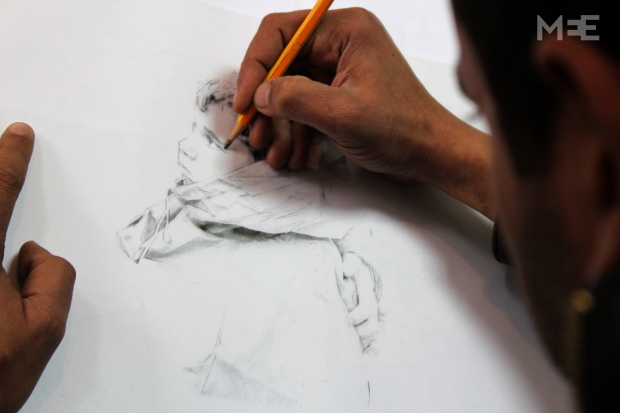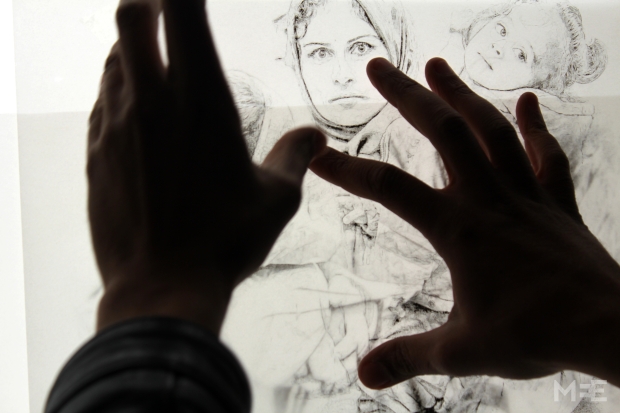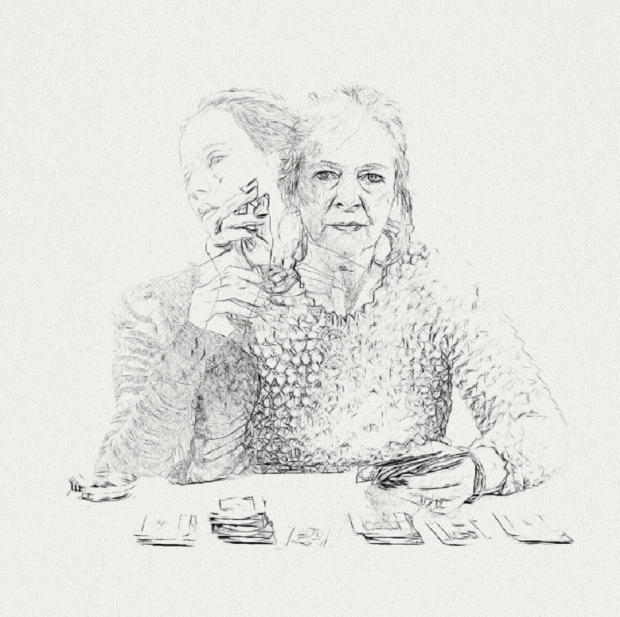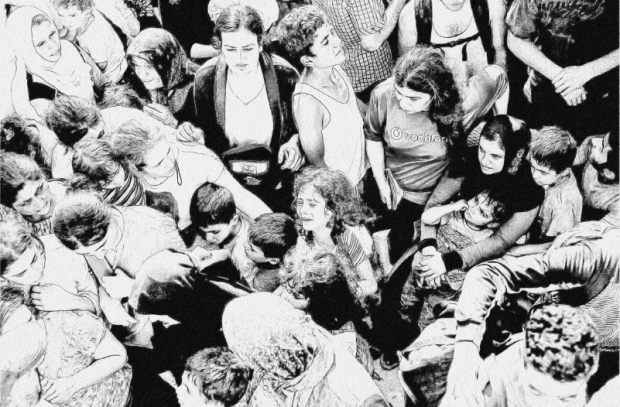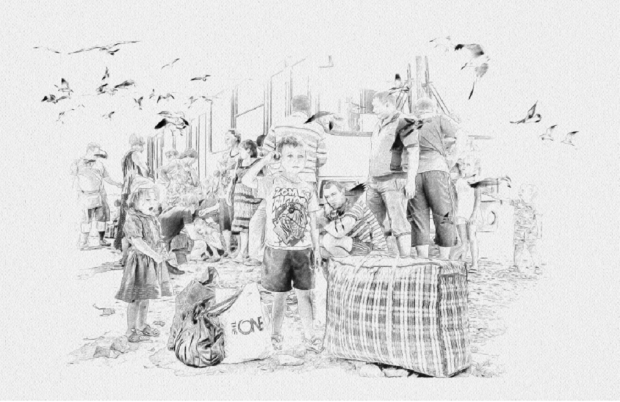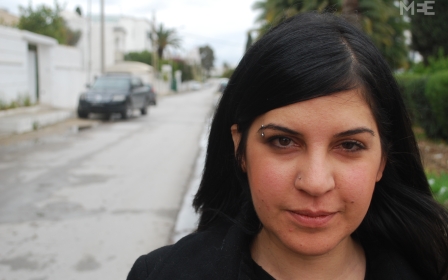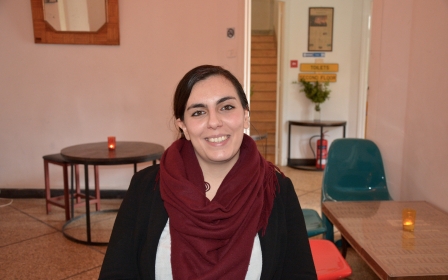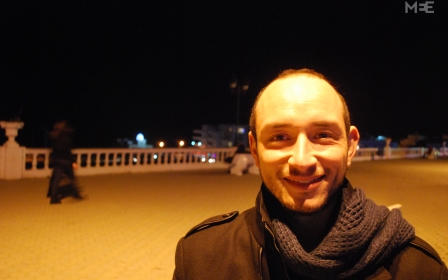Tunisian artist turns refugees' story from news to canvas
Othmane Taleb captures the pain and hopes of refugees using a self-styled artistic technique inspired by images he sees in the news

"Peregrinatione" study (Image courtesy of Othmane Taleb)
Published date: 18 April 2016 12:41 BST
|
Last update: 8 years 7 months ago
TUNIS - At first glance, from a distance, the artwork The Angelus looks as though it is simply a large white sheet of blank paper. But as you get nearer, the light sketchmarks become clearer and starker, revealing faces twisted in anguish in the crowds of refugees. The realisation of what you are looking at strikes at your very core.
In order to truly absorb every detail of the delicately drawn features on the pictures charting the refugees' exodus to Europe, one must get very close to the canvas. The lines are ever-so-lightly drawn in pencil, yet still manage to provide powerful imagery that one would normally only see as snippets on the daily news.
“When I copied the images taken by the photojournalists, I did not want to soften the expressions or to exaggerate them. I really wanted them to reflect as closely as possible what these people were feeling,” Othmane Taleb, the Algerian-born Tunisian artist who drew the creations, told Middle East Eye.
Like most people, the 38-year-old professional architect starts his day reading the news, except that Taleb's main focus is scouring for pictures from the refugee crisis in Europe and their harrowing journeys through various borders to reach their Promised Land.
When he was working on The Angelus for the Bardo Museum in Tunis, Taleb felt an inexplicable feeling of closeness to the people he was drawing. “Maybe it is because their story is universal, but I think it's also because I was used to seeing that same struggle in my own country. After the revolution, many people left Tunisia in boats to go to Europe. A lot of them died on that journey,” he said.
In addition to the nameless faces, some of the images of the refugees he has captured through his work are those who became modern icons: like the refugee who was kicked by a journalist in Hungary, and some of the parents who were seen precariously passing their children above barbed wire because they were desperate to get them to safety - images which were splashed all over international media.
Taleb tries to embody both contemporary and classic styles in his work. He is particularly keen on the Renaissance era. “I think that during that era, painters used to draw features with less anxiety, the faces were soft. Now, when we are faced with such difficult times, the features we see around us are much tighter. I want to show both, to express the discrepancy and the similarities between those historical periods,” he added.
When Taleb is drawing, he not only uses a pencil and a white piece of paper; it is a process that starts from his computer and ends up on his architect’s table. The artist uses a very particular technique that he wants to keep partly secret, using scans of his drawings to work on their superimposition and composition directly from his computer. He likes to superimpose sketches of one image from one photo over that of another, building the original photo into a more layered piece of art.
The intertwining of methods allows him to show several stages of emotions or sometimes different periods of time, exemplified in a recent series where he gave homage to elderly women being cast aside.
“I want to show every emotion and also how sometimes history repeats itself, which is why I use historic references. Then, I also try to show the mixing of cultures which is very present in the issue of refugees,” Taleb said. The difficulty is to make each expression visible through another. “That is why I use tracing paper to be able to draw the new image without erasing the first drawing,” he added.
His trademark style is to intertwine faces and produce a final work of art where people are mixed together, sometimes needing several sketches to grasp their facial expressions properly. To make the pieces harmonious, it can take two to eight months to think about the perfect composition, he said.
“It is not always despair, it can be joy when the migrants arrive or when they find their relatives who left before them,” he explained.
Hajer Azzouz is an interior designer and curator who noticed Taleb's distinct style. “What attracted me to Othamne’s work was his personal touch but also his influences from foreign artists.”
She put Taleb in touch with the only photographer of nudes in Tunisia, Sabri Ben Mlouka, so that they could work together on sketches involving bodies and mixing techniques.
“I think his drawing technique and his painting technique are very different, so it can be interesting to change the medium of work,” Azzouz added about his work with the photographer.
Reinvigorating the Bardo
In one of his main drawings exhibited in December at the Bardo museum, Taleb drew the different stages of the refugees' journey to escape war. On five different drawings which look like a fresco, an odyssey of war to exile, and despair to hope tells a compelling story.
The artist, whose work was displayed in a room not far from the famous collection of mosaics and antique sculptures, has gained a lot of visibility since then. It was the first time a contemporary art exhibit took place there since last March when two attackers shot 21 tourists and a policeman in the parking area, and inside the popular museum.
Three months after this attack, the city of Sousse was targeted by attackers who killed 38 holidaymakers, marking the end of the tourist season that most Tunisians had hoped would have been revived. Culturally rich Tunis has been left with a feeling of emptiness and a dead tourist industry.
For Taleb and other artists, the choice of having Bardo introduce their new work was an easy one. “We’ve all visited this museum at least once. It's part of our identity and history,” Taleb said. “It made sense to all of us to do an exhibition in this place; it has so much history and drama connected to it. It is also a place which corresponds to my work when I try to find bridges between different epochs,” he added.
After the exhibition's success, museum director Moncef Ben Moussa said that it had brought in a new artistic scene that could attract diverse audiences. “Put[ting] contemporary art in a museum usually more geared towards a focus on archaeology and antiquity only adds to the dynamism and life of this museum and we are planning two other contemporary art exhibitions in 2016."
Inspiration
Taleb's Tunis studio is small and looks like a storage room, yet by looking at the images strewn across the walls of his humble place of work, one can understand that he was inspired by various artists from different times.
“I studied Rembrandt and Caravaggio paintings for their use of light and the dramatic atmosphere in some of their works,” Taleb said. He is a self-made man when it comes to the art of drawing; born and partly raised in Algeria from an Tunisia father and an Algerian mother, he started drawing when he was a child.
“I used to borrow art books at the French Institute of Algiers and copy paintings from Edouard Manet,” he said. “I sought to copy the feel of the features he put in his paintings and also the purity of the composition.”
His architect father and economist mother enrolled him in art classes as a young boy, but the family left for Tunisia in the 90s when Taleb was eight. When he was older, Taleb studied architecture in Tunis and got a job in a firm which allowed him to travel frequently around Africa. “I was inspired by the faces of the people I met. We used to go to small villages to build houses. I met a lot of people in rural areas of Rwanda and Senegal,” he said.
These encounters led him to create a series on women and mothers called African Madonnas, which sought to show humanity as realistically as possible, using the likes of Lucian Freud and Jenny Saville as his inspiration. The women are seen at different stages of life: giving birth, ageing or working, or sometimes seen as foster mothers with trees protruding from their heads. “I like them because their way to draw features is closer to reality and to the nature of the human being,” he said.
An evolving artist
Sana Tamzini, a curator for Tunisia's Ministry of Culture and the director of the plastic arts department, believes Taleb’s work is still evolving, making it more interesting to his followers. “He is starting to be known worldwide but he needs to focus more on his drawings where his true trademark is," she said.
She has been following and buying his artwork for several years now, and for her the strengths of his drawings are both their political and social themes. “His paintings are more personal and the work on the oil-based technique could be improved whereas in his drawings, he has already mastered his own technique and created a new way of expressing universal values,” she added.
At first, Taleb used to draw on cardboard because it was less expensive than canvas. Now his studio is full of painted canvas, sketches and computer printout drafts. When he began his artistic endeavour, his goal was to exhibit in 2008, yet less than 10 years later he is showing his paintings and drawings at events worldwide.
“My first series as a painter were paintings in which I tried to replicate the drawings of my childhood. It was called Return to Innocence." Then when the reality of what was going on in the world around him caught his attention, he became obsessed with realism, especially in his work about migrants.
To add a touch of individualism to his figurative drawings of migrants that are evoked from copies of news pictures, he tried to add particular details or small objects that illustrate the personality of each character. “I imagined some of them would have lucky charms that they would take on a journey or the shiny metallic blanket some get when they are being rescued from a shipwreck,” he said.
He also studied the movements of the crowds of refugees - from when they were protesting to when they were leaving areas en masse. The dynamic of his drawing The Angelus revolved around the seemingly endless movement of people. “You can look at the picture from the right to the left or in reverse, each side has a story because there is no ending,” he said.
I want to stay free
In the next few months, Taleb will be exploring how to incorporate paint and colour in his works of superimposition. To keep up with his drawing practice, he also reproduces drawings for other artists from specialised websites.
Through the internet, he has sold a few paintings, including selling to overseas buyers, but reaching Tunisian curators is a difficult task. “It is not easy because there is not a well-structured art market in Tunisia and my themes are not ones you would want to hang in your living room,” he said.
Taleb does not seem to mind too much about getting exposure. “I don’t really care about success. I am more about taking my time. This is my passion, not my job and I want to keep it that way, in order to stay free.”
New MEE newsletter: Jerusalem Dispatch
Sign up to get the latest insights and analysis on Israel-Palestine, alongside Turkey Unpacked and other MEE newsletters
Middle East Eye delivers independent and unrivalled coverage and analysis of the Middle East, North Africa and beyond. To learn more about republishing this content and the associated fees, please fill out this form. More about MEE can be found here.


